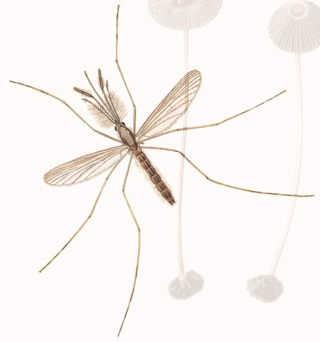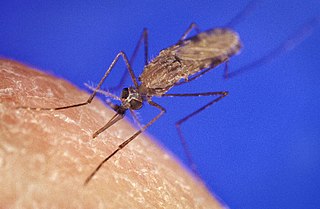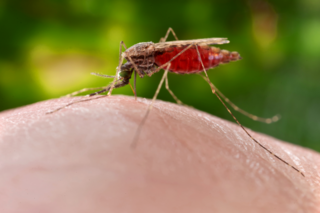
Mosquitoes, the Culicidae, are a family of small flies consisting of 3,600 species. The word mosquito is Spanish and Portuguese for little fly. Mosquitoes have a slender segmented body, one pair of wings, three pairs of long hair-like legs, and specialized, highly elongated, piercing-sucking mouthparts. All mosquitoes drink nectar from flowers; females of some species have in addition adapted to drink blood. Evolutionary biologists view mosquitoes as micropredators, small animals that parasitise larger ones by drinking their blood without immediately killing them. Medical parasitologists view mosquitoes instead as vectors of disease, carrying protozoan parasites or bacterial or viral pathogens from one host to another.

Anopheles is a genus of mosquito first described by J. W. Meigen in 1818, and are known as nail mosquitoes and marsh mosquitoes. Many such mosquitoes are vectors of the parasite Plasmodium, a genus of protozoans that cause malaria in birds, reptiles, and mammals, including humans. The Anopheles gambiae mosquito is the best-known species of marsh mosquito that transmits the Plasmodium falciparum, which is a malarial parasite deadly to human beings; no other mosquito genus is a vector of human malaria.

Anopheles culicifacies is a mosquito species complex and one of the primary vectors of malaria on the Indian subcontinent. It consists of five sibling species, provisionally designated as species A, B, C, D, and E. It prefers to rest indoors in cattle sheds, where it feeds on cattle. The control of A. culicifacies has become difficult due to the development of insecticide resistance against all commonly used insecticides, including new-generation insecticides such as synthetic pyrethroids.

Anopheles quadrimaculatus is a species of mosquito mainly located in Eastern United States, America. The species is a main vector of malaria.

Anopheles is a genus of mosquitoes (Culicidae) with about 484 recognised species.
Anopheles daciae is a species of mosquito that belongs to the Anhopheles maculipennis comple. Other species of this complex include Anopheles messeae, which can only be distinguished from Anopheles daciae by DNA analysis.

Lewis Wendell Hackett was an American physician who worked in Italy, Albania and South America to combat malaria.

Anopheles claviger is a mosquito species found in Palearctic realm covering Europe, North Africa, northern Arabian Peninsula, and northern Asia. It is responsible for transmitting malaria in some of these regions. The mosquito is made up of a species complex consisting of An. claviger sensu stricto and An. petragnani Del Vecchio. An. petragnani is found only in western Mediterranean region, and is reported to bite only animals; hence, it is not involved in human malaria.
The Walter Reed Biosystematics Unit ("WRBU") is a US Army organization that conducts laboratory and field research on the systematics of medically important arthropods in support of epidemiological investigations and disease prevention and control strategies of importance to the military. Research is carried out worldwide, within geographic or faunistic restrictions of the material available and military requirements. Research efforts focus on the development of accurate and reliable means of identifying vectors of arbopathogens of humans.

Anopheles freeborni, commonly known as the western malaria mosquito, is a species of mosquito in the family Culicidae. It is typically found in the western United States and Canada. Adults are brown to black, with yellow-brown hairs and gray-brown stripes on the thorax. Their scaly wings have four dark spots, which are less distinct in the male.
Anopheles nuneztovari is a species of mosquito in the order Diptera native to South America. The species was named by its discoverer, Arnoldo Gabaldón, to honor the Venezuelan entomologist Manuel Núñez Tovar.

Airport malaria, sometimes known as baggage, luggage or suitcasemalaria, occurs when a malaria infected female Anopheles mosquito travels by aircraft from a country where malaria is common, arrives in a country where malaria is usually not found, and bites a person at or around the vicinity of the airport, or if the climate is suitable, travels in luggage and bites a person further away. The infected person usually presents with a fever in the absence of a recent travel history. There is often no suspicion of malaria, resulting in a delay in diagnosis. It is typically considered as a diagnosis after other explanations for symptoms have been ruled out.

Anopheles atroparvus is a European species of mosquito, which was first identified in 1927. It is one of the most abundant palearctic Anopheles species belonging to the family Culicidae, commonly called mosquitoes. Although research interest in A. atroparvus has been low in the past several decades, recent concern for an increase in vector-borne disease has encouraged new research into this species.
Anopheles bellator is a species of mosquito mainly located in southeast of State of São Paulo, Brazil, is a main vector of malaria.
Anopheles moucheti is a species of mosquito. It is an anthropophile. It can be mainly located in Congo Basin forest, Central Africa. It was the main vector of malaria.

Anopheles hermsi is a species of mosquito in the family Culicidae. It is a known vector of Plasmodium vivax malaria. An. hermsi have been collected in Southern California.

Anopheles merus is a species of mosquito that can be found in coastal areas of Eastern and Southern Africa. The species is a main vector of malaria.

Anopheles quadriannulatus is a species of mosquito that can be found in Sub-Saharan Africa with the exception of West Africa and Madagascar. The species is a vector of malaria.

Anopheles farauti is a species of mosquito that is an important malaria vector occurring in Papua New Guinea, neighbouring islands and Australia. A. farauti is common in coastal areas and breeds in brackish water rich in organic matter. It is often found in coastal swamps and mangrove forests.

Anopheles plumbeus is a species of mosquito found in Europe and can also be found in the near East and northern Africa. It is anthropophilic and can be a nuisance mosquito, biting persistently during dawn, dusk and also during the day. A. plumbeus can transmit the malaria agent Plasmodium falciparum. A. plumbeus has been collected from forested areas, but also from rural and urban areas. It breeds in treeholes, water-filled containers or discarded tyres. The species is similar in appearance to A. claviger.














